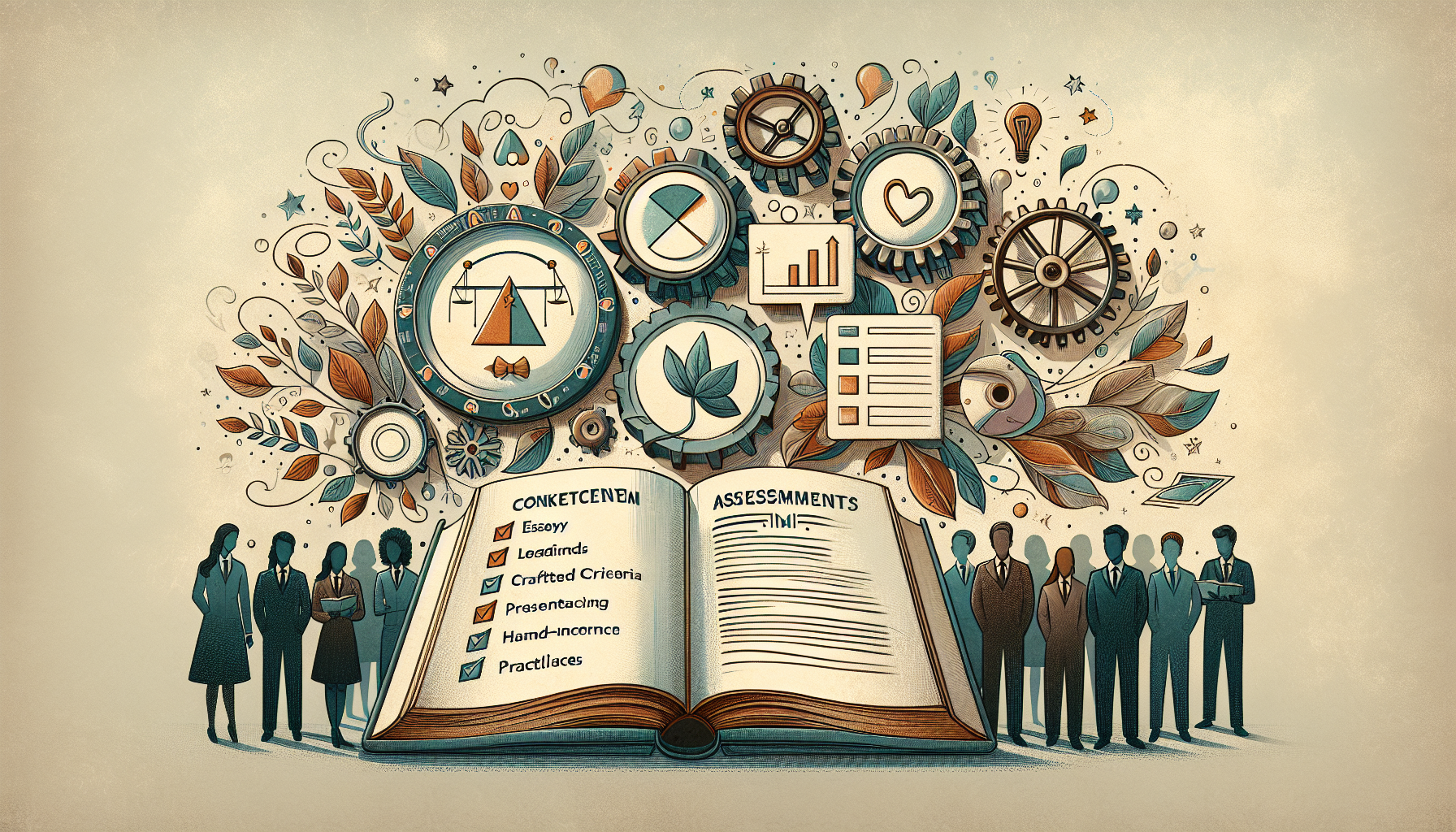Creating competency-based assessments for online learners can feel like trying to find your way through a maze. With all the options and techniques available, it’s easy to get overwhelmed. You might wonder how to ensure your assessments truly reflect your learners’ skills and abilities. It’s a common struggle!
But don’t worry, if you stick around, I promise we’ll break it down into manageable steps. By the end, you’ll have a clear framework to design meaningful assessments that cater to online learning environments, making the whole process a lot simpler and more effective.
From understanding what competency-based assessment is to identifying key competencies and crafting effective tools, we’re going to cover everything you need. Let’s dive in and transform your assessments into powerful learning experiences!
Key Takeaways
- Competency-based assessments focus on what learners can do rather than the time they spend learning.
- Identify key competencies based on course goals and real-world needs before creating assessments.
- Use a variety of assessment tools, like projects and quizzes, to engage learners effectively.
- Integrate assessments into your course schedule for transparency and clarity.
- Measure performance using both qualitative and quantitative data for comprehensive insight.
- Provide timely, specific feedback and establish support systems for continuous improvement.
- Regularly evaluate and revise assessments to ensure they remain effective and relevant.

Steps to Create Competency-Based Assessments for Online Learners
Understanding Competency-Based Assessment
Competency-based assessment is all about evaluating learners’ skills, knowledge, and abilities against specific competencies. This approach focuses on what learners can do, rather than how much time they spend learning.
Practically, it means setting clear benchmarks and outlining what mastery looks like for each competency. Using examples, learners might demonstrate their ability to solve a real-world problem or create a project based on learned concepts.
What’s great about this system is that it allows learners to progress at their own pace. If someone masters a skill quickly, why should they stick around waiting for others? Competency-based assessment gives them the freedom to move forward.
To get the most value from this approach, you should ensure that assessments are clear, relevant, and tied to real-world applications. Consider tools like rubrics to guide assessment and help learners understand expectations upfront.
Identifying Competencies for Online Learning
Identifying the right competencies is crucial for effective online learning assessments. Start by looking at the goals of your course or program. What should learners be able to know or do by the end?
You can break down overarching objectives into specific skills or knowledge areas. For example, if you’re teaching a coding course, competencies might include understanding algorithms, debugging, or designing user interfaces.
Engaging stakeholders—like industry professionals or potential employers—for feedback can also provide insight into what competencies are most valuable in the real world. They might have a unique perspective on what skills are in demand.
Once you have a list of competencies, prioritize them based on relevance and importance to learners’ future success. This will make sure you’re focusing on what really matters. You can also use approaches like [content mapping](https://createaicourse.com/content-mapping/) to visualize these connections more clearly.
Designing Effective Assessment Tools
When it comes to designing assessment tools, start by considering the type of assessment that best fits each competency. Would a project, a quiz, or a presentation work best?
Keep in mind that variety can keep learners engaged. For instance, combining traditional quizzes with hands-on projects provides a well-rounded assessment experience. Sometimes a digital portfolio showcases skills better than any exam.
Think about accessibility when creating these tools. Make sure that assessments can be completed independently and are user-friendly. Tools like Google Forms for quizzes or platforms for creating digital portfolios can be a lifesaver.
Lastly, don’t underestimate the power of self-assessment. Encouraging learners to reflect on their progress can foster ownership of their learning. This can be as simple as having them write a short paragraph about what they learned after a project.
Implementing Assessments in Online Courses
Implementation is where the rubber meets the road. Make sure your assessments are integrated into the course schedule clearly so learners know when to expect them.
Open communication is key. Be transparent about assessment criteria, timelines, and support resources. Consider hosting a live orientation session or providing recorded tutorials on how to access and complete assessments.
To make the process smoother, use online learning management systems (LMS) that can help automate scheduling and submissions. Platforms like Moodle or [Teachable](https://createaicourse.com/teachable-vs-thinkific/) make managing assessments a whole lot easier.
Implementing formative assessments during the course can also guide learners as they progress. Small checkpoints allow for adjustments before they tackle a final assessment.

Measuring Learner Performance
Measuring learner performance is essential in a competency-based system, as it helps you understand where students excel and where they may need extra support.
Start by defining your metrics. What specific indicators will show that learners have mastered the competencies you outlined? These could include scores from assessments, quality of work, or even participation in discussions.
Use both formative and summative assessments to gather a full picture of learner performance. Formative assessments give ongoing feedback, while summative assessments evaluate overall competency at the end of a lesson or course.
Leverage analytics features in your online learning management systems (LMS) to track and analyze learner performance effectively. Many LMS platforms allow you to see trends over time, providing insights into learner engagement.
Don’t solely rely on quantitative data. Qualitative feedback, such as learner reflections or peer evaluations, can offer valuable context to learners’ performance metrics.
Providing Feedback and Support
Feedback is critical in competency-based assessments; it’s how learners improve and grow.
Offer timely, specific, and actionable feedback. Instead of saying, “Good job,” explain why they did well and what they can improve next time.
Consider using video or audio feedback. This personal touch can make a big difference in how learners perceive their progress and can help build rapport.
Encourage a growth mindset by framing feedback positively. Remind learners that mistakes are part of the learning process and every error is an opportunity to learn.
Set up support systems, such as discussion forums or virtual office hours, where learners can ask questions or discuss challenges while working on their competencies.
Using peer review can also be beneficial. It not only provides learners with diverse feedback but also encourages them to critically analyze work from others.
Evaluating and Revising Your Assessments
Evaluation and revision of assessments are crucial for keeping them relevant and effective over time.
Regularly collect data on how assessments perform. Are students consistently struggling with a particular competency? This data can indicate that you might need to adjust your assessment tool or the material leading up to it.
Solicit feedback from learners about the assessments themselves. Were they clear? Did they accurately measure competencies? Use these insights to iterate and improve.
Stay updated with industry standards and emerging trends in the field. Continuous professional development can help inform how you revise your assessments.
Remember to pilot any new assessments or revisions before full implementation. Getting a small group’s input can reveal potential issues before wider rollout.

Best Practices for Competency-Based Assessments
Implementing effective competency-based assessments requires attention to best practices that enhance both the learning experience and evaluation accuracy.
Start by ensuring alignment between assessments and learning objectives. What you measure should reflect what you want learners to achieve.
Create clear, measurable criteria for each competency. This allows learners to understand how they will be evaluated and what outcomes they should strive for.
Diversify your assessment methods to cater to different learning styles. Incorporating multiple formats—like written assignments, presentations, and practical tasks—means all learners can shine in ways that suit them best.
Incorporate real-world applications where possible. Use case studies or simulations that require learners to apply their knowledge in contexts they may encounter in their careers.
Encourage reflection throughout the learning process. Prompt learners to think about what they’ve learned after each assessment, helping them internalize new skills more deeply.
Lastly, foster a culture of continuous improvement. Both you and the learners should be on a journey of growth, regularly revisiting and revising strategies based on feedback and performance data.
FAQs
Competency-based assessment evaluates learners based on their ability to demonstrate specific skills and knowledge, rather than traditional methods that focus on time spent in a course or other metrics.
Identify competencies by analyzing course objectives, consulting industry standards, and collaborating with subject matter experts to ensure that selected competencies align with both learner needs and course goals.
Best practices include aligning assessments with learning objectives, using diverse assessment formats, ensuring clarity in instructions, and incorporating opportunities for learner reflection to enhance the assessment experience.
Provide feedback promptly and focus on specific strengths and areas for improvement. Use examples from the work submitted and encourage a growth mindset to promote ongoing learner engagement and development.
